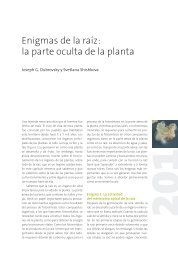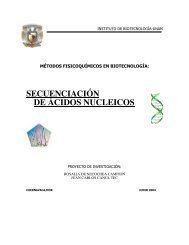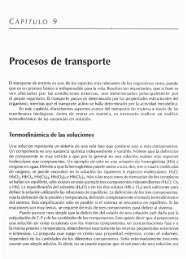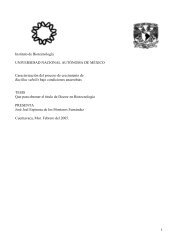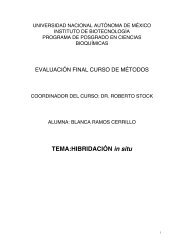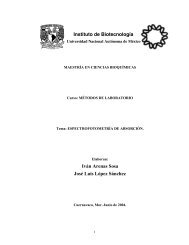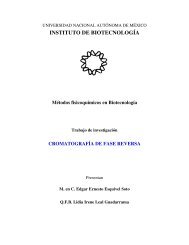Interaction of the virulence protein VirF of Agrobacterium ...
Interaction of the virulence protein VirF of Agrobacterium ...
Interaction of the virulence protein VirF of Agrobacterium ...
You also want an ePaper? Increase the reach of your titles
YUMPU automatically turns print PDFs into web optimized ePapers that Google loves.
Brief Communication 261<br />
mutation in <strong>the</strong> octopine type Ti plasmid with diminished been identified. This substrate must be ano<strong>the</strong>r direct<br />
<strong>virulence</strong> on tomatoes [18]. Later, Nicotiana glauca was interaction partner <strong>of</strong> <strong>VirF</strong>. However, this has so far not<br />
found to be <strong>the</strong> preferred host for studying <strong>the</strong> effects <strong>of</strong> been identified in two-hybrid screens. The reason may<br />
virF mutations [7]. On o<strong>the</strong>r hosts, <strong>the</strong> role <strong>of</strong> virF in be that <strong>the</strong> substrate needs to be modified in order for<br />
transformation only becomes clear upon <strong>the</strong> mutation <strong>of</strong> <strong>the</strong> interaction to take place. It is known that many targets<br />
a second gene, called virE3 (our unpublished results). must first be phosphorylated and can subsequently inter-<br />
The mutation <strong>of</strong> virE3 by itself has no or only mild negative<br />
effects on <strong>the</strong> <strong>virulence</strong> <strong>of</strong> <strong>Agrobacterium</strong>, but subse-<br />
act with <strong>the</strong> SCF complex [12–15, 20].<br />
quent mutation <strong>of</strong> virF leads to strongly diminished <strong>virulence</strong>.<br />
Apparently, <strong>the</strong>re seems to be some redundancy<br />
in <strong>the</strong> functions mediated by <strong>the</strong> <strong>VirF</strong> and VirE3 <strong>protein</strong>s.<br />
The VirE3 <strong>protein</strong>, like VirE2 and <strong>VirF</strong>, contains <strong>the</strong><br />
amino acid motif Arg-Pro-Arg at <strong>the</strong> C terminus. This<br />
motif forms part <strong>of</strong> <strong>the</strong> transport signal, which is recognized<br />
by <strong>the</strong> VirB/VirD4 channel, which mediates <strong>protein</strong><br />
The precise mechanism whereby <strong>VirF</strong> affects tumorigen-<br />
esis awaits fur<strong>the</strong>r study, including <strong>the</strong> identification <strong>of</strong><br />
<strong>the</strong> <strong>protein</strong>s, which are targeted by <strong>VirF</strong> for proteolysis.<br />
But <strong>the</strong> results obtained so far once more illustrate <strong>the</strong><br />
sophistication <strong>of</strong> plant tumor induction by <strong>the</strong> bacterium<br />
A. tumefaciens.<br />
secretion directly from <strong>Agrobacterium</strong> into <strong>the</strong> plant cell Acknowledgements<br />
[6]. This suggests that VirE3 is also secreted by A. tumefa- We thank Susanne E. Kohalmi for kindly providing <strong>the</strong> Arabidopsis thaliana<br />
ciens into plant cells via <strong>the</strong> VirB/VirD4 transport system,<br />
as has been shown for VirE2 and <strong>VirF</strong> [6]. There is no<br />
o<strong>the</strong>r similarity between <strong>the</strong> <strong>VirF</strong> and VirE3 <strong>protein</strong>s.<br />
cDNA library, <strong>the</strong> pBI770 and pBI771 plasmids, <strong>the</strong> YPB2 strain, and <strong>the</strong><br />
HisASK1 antibodies. We thank Jan Schouten for kindly providing plasmids<br />
with <strong>the</strong> A.thaliana ASK genes. The work <strong>of</strong> Werner Pansegrau was financed<br />
by EU-FP5 research training grant ERB4001GT963065 <strong>of</strong> <strong>the</strong> European<br />
Also, in contrast to <strong>VirF</strong>, VirE3 contains putative nuclear<br />
localization signal sequences, which suggest a function<br />
Community. This work was supported by <strong>the</strong> Ne<strong>the</strong>rlands Foundation for<br />
Chemical Research (SON) with financial aid from <strong>the</strong> Ne<strong>the</strong>rlands Organiza-<br />
tion for Scientific Research (NWO). Thanks are due to Drs. L. Banta, R.<br />
for VirE3 in <strong>the</strong> plant cell nucleus. VirE3 may thus compensate<br />
for <strong>the</strong> absence <strong>of</strong> <strong>VirF</strong> by an entirely different<br />
Offringa, and E.J. van der Zaal for critical reading <strong>of</strong> <strong>the</strong> manuscript.<br />
molecular mechanism <strong>of</strong> action. References<br />
1. Kado CI: Molecular mechanisms <strong>of</strong> crown gall tumorigenesis.<br />
Critical Reviews in Plant Sciences 1991, 10:1-32.<br />
In view <strong>of</strong> <strong>the</strong> strong conservation <strong>of</strong> <strong>the</strong> Skp1 <strong>protein</strong>s,<br />
we predict that Skp1 <strong>protein</strong>s <strong>of</strong> o<strong>the</strong>r plant species such<br />
as N. glauca will interact with <strong>VirF</strong> similarly to <strong>the</strong> way<br />
2.<br />
3.<br />
Hooykaas PJJ, Beijersbergen AGM: The <strong>virulence</strong> system <strong>of</strong><br />
<strong>Agrobacterium</strong> tumefaciens. Annu Rev Phytopathol 1994,<br />
32:157-179.<br />
Zupan J, Zambryski P: The <strong>Agrobacterium</strong> tumefaciens DNA<br />
transfer complex. Critical Reviews in Plant Sciences 1997,<br />
in which A. thaliana Skp1 homologs do. F box <strong>protein</strong>s 16:279-295.<br />
form part <strong>of</strong> SCF complex ubiquitin ligases and determine<br />
which substrate <strong>protein</strong>s will be targeted for ubiquitination<br />
and subsequent proteolysis by <strong>the</strong> proteasome. Such<br />
4.<br />
5.<br />
Winans SC: Two-way chemical signaling in <strong>Agrobacterium</strong>-<br />
plant interactions. Microbiol Rev 1992, 56:12-31.<br />
Christie PJ: <strong>Agrobacterium</strong> tumefaciens T-complex transport<br />
apparatus: a paradigm for a new family <strong>of</strong> multifunctional<br />
substrates include promoters and inhibitors <strong>of</strong> <strong>the</strong> cell<br />
cycle as well as signal transduction components. F box<br />
6.<br />
transporters in eubacteria. J Bacteriol 1997, 179:3085-3094.<br />
Vergunst AC, Schrammeijer B, den Dulk-Ras A, de Vlaam CM,<br />
Regensburg-Tuïnk TJ, Hooykaas PJ: VirB/D4-dependent<br />
<strong>protein</strong>s thus play an important regulatory role in <strong>the</strong> <strong>protein</strong> translocation from <strong>Agrobacterium</strong> into plant cells.<br />
control <strong>of</strong> cell division and differentiation and, consequently,<br />
in <strong>the</strong> growth and development <strong>of</strong> eukaryotic<br />
7.<br />
Science 2000, 290:979-982.<br />
Melchers LS, Maroney MJ, den Dulk-Ras A, Thompson DV, van Vuuren<br />
HA, Schilperoort RA, Hooykaas PJ: Octopine and nopaline<br />
organisms. It may be that <strong>VirF</strong>, as part <strong>of</strong> an SCF complex,<br />
likewise affects <strong>the</strong> cell cycle. For instance, maintaining<br />
strains <strong>of</strong> <strong>Agrobacterium</strong> tumefaciens differ in <strong>virulence</strong>;<br />
molecular characterization <strong>of</strong> <strong>the</strong> virF locus. Plant Mol Biol<br />
1990, 14:249-259.<br />
cells for an extended period <strong>of</strong> time in <strong>the</strong> S-phase may 8. Regensburg-Tuïnk AJ, Hooykaas PJ: Transgenic N. glauca plants<br />
expressing bacterial <strong>virulence</strong> gene virF are converted into<br />
facilitate T-DNA integration. In <strong>the</strong> plant cell, <strong>VirF</strong> seems hosts for nopaline strains <strong>of</strong> A. tumefaciens. Nature 1993,<br />
to play a role specifically during <strong>the</strong> infection by Agrobac- 363:69-71.<br />
terium since <strong>VirF</strong> transgenic plants show no aberrant phe-<br />
9. Kohalmi SE, Nowak J, Crosby WL: A practical guide to using <strong>the</strong><br />
notype (data not shown). The latter may be due to <strong>the</strong><br />
inherent instability <strong>of</strong> F box <strong>protein</strong>s, which are targeted<br />
yeast 2-hybrid system. InDifferentially Expressed Genes in<br />
Plants: A Bench Manual. Edited by Harper G and Hansen E. London:<br />
Taylor & Francis; 1997:63-82.<br />
for destruction by ubiquitination during <strong>the</strong>ir transient<br />
presence in <strong>the</strong> SCF complex [19]. In recent transport<br />
10. Kohalmi SE, Reader LJV, Samach A, Nowak J, Haughn GW, Crosby<br />
WL: Identification and characterization <strong>of</strong> <strong>protein</strong><br />
interactions using <strong>the</strong> yeast 2-hybrid system. InPlant Molecular<br />
experiments, <strong>the</strong> delivery <strong>of</strong> a NLS::Cre::<strong>VirF</strong> fusion pro- Biology Manual M1. Edited by Gelvin SB and Schilperoort RA.<br />
Dordrecht, The Ne<strong>the</strong>rlands: Kluwer Academic Publishers;<br />
tein into plant cells seemed to occur much more efficiently<br />
after deletion <strong>of</strong> <strong>the</strong> F box [6]. This may be due not so<br />
1998:1-30.<br />
much to enhanced transport as to enhanced stability after <strong>protein</strong> interactions. Nature 1989, 340:245-246.<br />
deletion <strong>of</strong> <strong>the</strong> F box. A full understanding <strong>of</strong> <strong>the</strong> function SKP1 connects cell cycle regulators to <strong>the</strong> ubiquitin<br />
<strong>of</strong> <strong>VirF</strong> will not be possible until <strong>the</strong> <strong>the</strong> participation <strong>of</strong><br />
<strong>VirF</strong> in an SCF complex is experimentally confirmed and<br />
<strong>the</strong> substrate targeted for proteolysis by <strong>the</strong> complex has<br />
13.<br />
1996, 86:263-274.<br />
Skowyra D, Craig KL, Tyers M, Elledge SJ, Harper JW: F-box<br />
<strong>protein</strong>s are receptors that recruit phosphorylated<br />
11. Fields S, Song O: A novel genetic system to detect <strong>protein</strong>-<br />
12. Bai C, Sen P, H<strong>of</strong>mann K, Ma L, Goebl M, Harper JW, Elledge SJ:<br />
proteolysis machinery through a novel motif, <strong>the</strong> F-box. Cell




